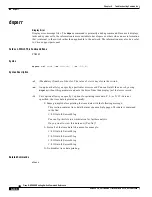
9-103
Cisco MGX 8850 Routing Switch Command Reference
Release 2.0, Part Number 78-10467-04 Rev C0, October 2001
Chapter 9
Troubleshooting Commands
dspenvalms
dspenvalms
Display Environment Alarms
Display alarms related to the environment of the node. The monitored categories are:
•
Temperature inside the enclosure
•
AC power supplies if applicable
•
DC supply power
•
DC system power
•
Bottom fan tray operation
•
Top fan tray operation
The definition of each alarm severity comes from Bellcore TR-NWT-000474. An alarm can be:
•
Critical, indicating complete, non-recoverable failure, loss of data, and do on. The failed entity must
be restored. A power failure or a line being disconnected is an example.
•
Major, indicating service-affecting errors. This event indicates that a major service is damaged or
lost, but the existing traffic is not affected.
•
Minor, indicating non-service affecting errors or errors on a remote node. Corrective action is
appropriate to prevent a serious fault from developing. An example is a fan failure, where no
subscribers are immediately affected, but calamity could result if the situation persists. Note that an
accumulation of lower-level alarms does equal a higher-level alarm.
The dspenvalms command is part of a hierarchy of troubleshooting commands you can execute on the
PXM45. Frequently, dspenvalms follows the higher-level command dspndalms. The dspndalms
command shows a variety of alarm types within the switch and helps isolate the problem.
Cards on Which This Command Runs
PXM45
Syntax
dspenvalms
[
temp
]
[
psu
]
[
fan
]
[
vmon
]
Syntax Description
temp
(temperature) shows the temperature and whether an alarm condition exists.
psw
(power supply units) shows how many AC power supplies reside in the power supply
tray, and also shows the high and low DC output values that the AC power supplies
should be able to maintain.
fan
shows the presence of top and bottom fan trays, minimum rotation rate of each fan,
and actual rotation rate of each fan in RPMs.
















































